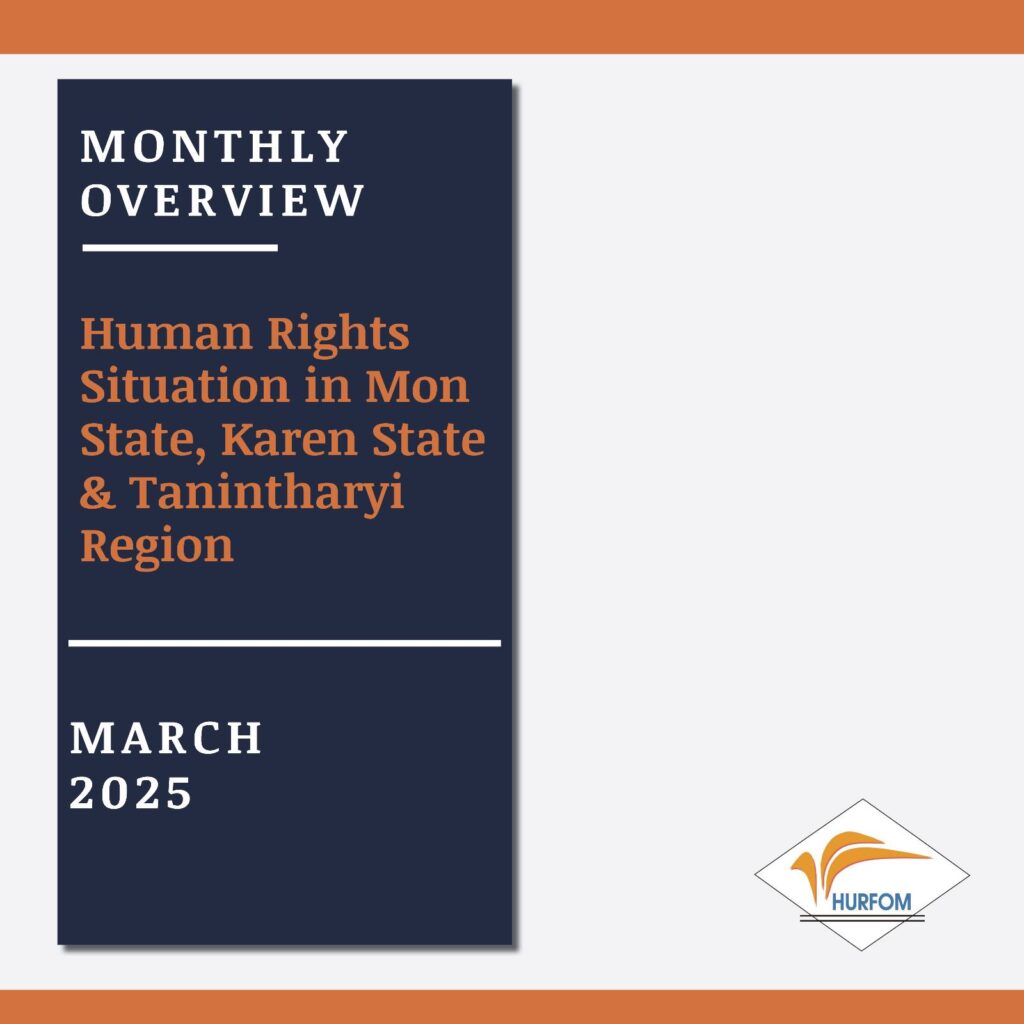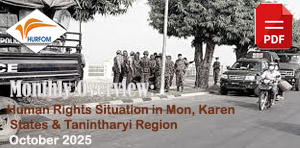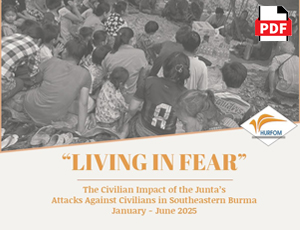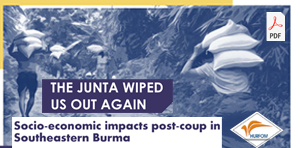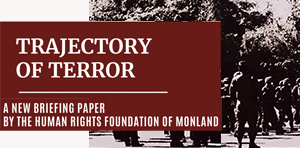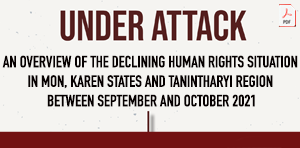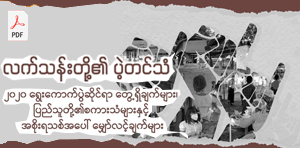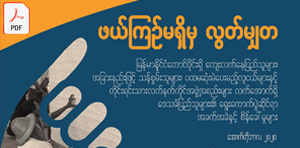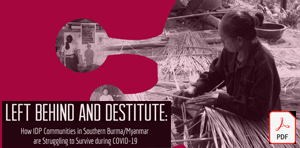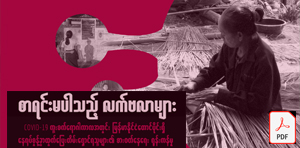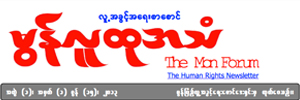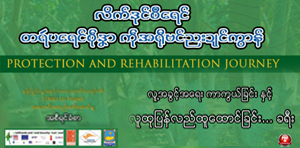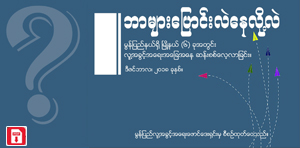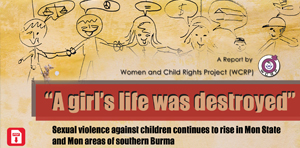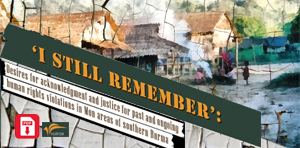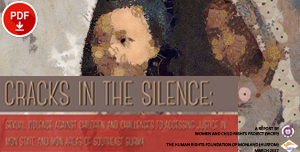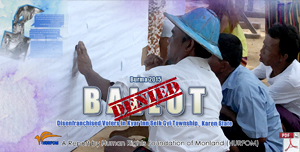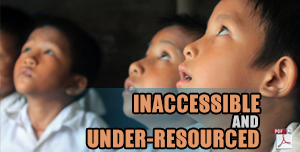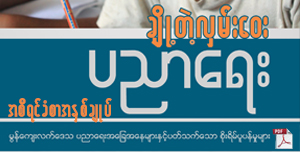Monthly Overview: Indiscriminate Attacks by the Military Junta Lead to Widespread Forced Displacement and Ongoing Fears in Southeastern Burma
March 31, 2025
Civilians are under constant attack and face serious threats to their overall well-being in targeted areas of the Human Rights Foundation of Monland (HURFOM), including Mon State, Karen State, and the Tanintharyi region. The escalation of assaults by the military junta has deprived children of safe pathways to education and seriously undermined livelihood opportunities for families. In a case documented by HURFOM at the beginning of the month, the junta’s violent and unpredictable presence prevented 500 internally displaced people from returning to their villages.
Despite no active fighting around Kyone Long (Old) village in Ye Township, Mon State, junta troops remain stationed in the area, preventing 456 displaced villagers from going home. Junta soldiers set up camp at a monastery in Eye Poke village, creating an atmosphere of fear and insecurity for those who fled.
“We don’t dare to return as long as the military is in the village. It’s simply not safe. Right now, going back home would mean risking our lives,” said a displaced villager.
With their homes still inaccessible, many villagers have been forced to take refuge in the mountains, forests, and plantations near Pha Lan Chaung Wa and Upper Yit Chaung villages, under the control of the New Mon State Party. Some families from Well Bine and Well Zin have attempted to return, but they only stay home during the day and retreat to the nearby forests and plantations for safety at night.
“Even those who returned to their villages can only stay during daylight hours. Once night falls, they have no choice but to sleep elsewhere for their safety,” a recently returned villager said.
For those still displaced, the uncertainty continues. As long as junta troops occupy their villages, returning home remains a distant hope, especially as enforced disappearances are on the rise. Eighteen displaced villagers from Thein Khun village, Tanintharyi Township, who the military junta arrested during its offensive operations, remain in detention more than a week later, with no contact with their families. Local sources and aid workers assisting displaced persons have confirmed their continued disappearance.
Since December 17th, 2024, residents of Thein Khun, a village along the Thailand-Burma border trade route, have been forced to flee as military offensives and clashes escalate in the area. On February 28, at 1 PM, junta forces reportedly arrested 18 displaced villagers while they were picking betel nuts in plantations near their village.
“We still haven’t been able to contact them, and they have not been released yet. We heard that the junta forces took them away, but we don’t know where,” said a resident.
The detained group includes nine men and nine women, all from Thein Khun village. Many of them belong to the same families or are closely related. Meanwhile, on February 15, at least five houses were burned down by junta troops stationed inside Thein Khun village. Artillery shelling and airstrikes have also destroyed numerous homes, leaving the community in devastation.
Indiscriminate Attacks
The junta’s indiscriminate attacks include airstrikes, artillery fire and shooting. According to local sources, the junta launched an airstrike on Winka Phaw village, located in the Taung Pyae Ok area of Tha Yet Chaung Township, Dawei District, despite no active fighting in the area. At approximately 1:30 PM on March 3, a junta jet fighter dropped bombs on the village, causing injuries and destruction. Reports confirm that four civilians were injured, including a 10-year-old boy, a woman in her 60s, a man in his 50s, and another man in his 40s.
“Four people were wounded. One elderly man’s condition is particularly concerning. Based on the impact, we estimate the bomb weighed around 500 pounds,” said a resident.
A Thae Chaung Gyi village resident mentioned that only two injuries had been confirmed. However, further details remain unclear due to communication difficulties, such as ongoing power cuts by the junta, in further attempts to isolate conflict-affected communities.
The Karen National Union Thaton District also reported on an airstrike by the junta that was deployed against Mae Thana and Htee Kyaw Khee villages in Hpa-An Township, Karen State, despite no active clashes in the area. The airstrike took place at 6:00 AM on March 1, when a junta jet fighter dropped at least four bombs on the two villages.
The attack damaged homes and religious buildings, including a monastery at the base of Mae Thana Hill. The airstrike also forced students to stop attending school, and many villagers were forced to flee their homes in search of safety. According to the KNU Thaton District, the bombs dropped included 120mm bombs and handmade cluster bombs, further escalating fears among local communities.
This is not the first time the junta has targeted civilian areas in Hpa-An Township. On February 9, another airstrike hit Tagay Laung village, destroying ten buildings, including a monastery hall.
The junta’s continued airstrikes on villages, schools, and religious sites have left thousands displaced and struggling to rebuild their lives. With no armed resistance reported in the area, these attacks appear to be deliberate attempts to terrorize civilians and drive them from their homes.
Since the start of 2025, fighting between the Karen National Liberation Army (KNLA) resistance forces and the junta troops in southern Kawkareik Township, Karen State, has continued to escalate. However, despite the active clashes, the junta has increasingly targeted civilian villages with airstrikes, forcing thousands to flee their homes.
In the early hours of March 5, at 1:30 AM, a junta fighter jet dropped bombs twice on Ah-Soon village in southern Kawkareik Township. The attack destroyed five houses and injured two civilians. A day earlier, on March 4, at around 1 PM, the junta launched another airstrike targeting Dauk Phalan village, where a school was hit and damaged. Reports from the ground indicate that there were civilian casualties, though the exact number remains unknown.
Residents have also reported intensifying clashes in late February 2025 and early March near Koh Nwah and Ywa Thit Gone villages near Kawkareik. The junta has launched repeated ground offensives, facing strong resistance from the KNLA and allied forces.
As a result, the junta’s troops, who suffered heavy casualties, retaliated by targeting civilian homes. Reports indicate that hundreds of houses in Koh Nwah and Ywa Thit Gone villages were set on fire by junta forces, forcing more families into displacement. Additionally, Boh Dai, San Phalar, and Ah-Soon—areas not directly involved in the ongoing clashes—have been repeatedly bombed by junta aircraft during the first few weeks of the month.
With the situation deteriorating rapidly, many residents have tried to stockpile food and supplies, fearing further displacement. However, locals stated that junta troops have imposed restrictions on the transportation of essential goods, making it increasingly difficult to access food and other necessities.
Although Kawkareik town was previously captured by resistance forces in 2024, the junta has managed to regain control through continuous air support and heavy offensives. As a result, junta troops are now stationed inside Kawkareik town, tightening their grip on the area.
The continued targeting of civilian villages and destruction of homes and schools have exacerbated the humanitarian crisis in southern Kawkareik Township. With thousands displaced and food supplies dwindling, affected communities desperately seek refuge and urgent humanitarian assistance.
“The junta is deliberately attacking areas where there are no clashes. They are trying to terrorize civilians and weaken local resistance by making daily life impossible,” said a resident from Kawkareik.
On March 13, clashes erupted between the People’s Defense Forces (PDFs) and the military junta in Launglon Township, Dawei District. According to local sources, the PDFs launched simultaneous attacks on two junta bases—the Maungmagan Police Station and the Lek Khat Taung military base between Launglon town and Sanlam village. The fighting began around 7:00 AM, prompting the junta to respond with airstrikes and naval fire. During the attack on Maungmagan Police Station, four civilians were injured by bomb fragments.
At 10:00 AM, a junta jet fighter arrived, dropping two bombs on Lek Khat Taung and opening fire with machine guns. Meanwhile, the junta’s navy in the western sea provided additional support by launching artillery strikes.
“Four villagers were injured. The navy fired at us first. Then a military jet dropped bombs and continued shooting,” said a resident.

By 1:00 PM, another airstrike targeted the Lek Khat Taung area. Among the injured was a mother carrying her nursing baby, who sustained severe abdominal wounds from a bomb fragment. Three others—two men and an elderly woman—suffered arm injuries.
“The mother was badly injured, with multiple wounds. Another injured person is an elderly woman who was hit in the arm. The two men sustained minor injuries,” a resident explained.
Although the gunfire in the Maungmagan area had subsided by noon, sporadic shooting continued near Lek Khat Taung. The battle occurred on the full moon day of March (Ta Paung La), a time when religious donation ceremonies were taking place in Launglon Township, adding to the tragedy of the attack.
A father and his son were seriously injured when an artillery shell fired by the military junta exploded in Zeekya village, near Dawei Technological University, at 10 AM on March 18th. The attack occurred when junta forces stationed at Kyauk Kanyar-based Artillery Regiment Command No. 304 launched heavy artillery fire toward civilian areas.
One of the shells landed near the Zeekya village toll gate, where the son worked on farmland. The explosion resulted in the loss of one of his hands, while his father sustained a severe injury to his waist, a local witness reported.
“Both of them suffered serious injuries. They have been taken to Dawei Hospital for treatment,” said a resident.
According to sources, the attack may have been linked to recent clashes at the Burumae checkpoint, where junta troops reportedly suffered casualties. However, no armed resistance groups were present during the shelling. A former township-level member of a political party in Dawei, speaking anonymously on March 19, shared his perspective:
“The junta is using all its firepower and military strategies to intimidate both civilians and resistance forces. Even when there is no direct battle, they continue indiscriminate attacks with artillery and drones. They want to instill fear and maintain control over these areas. More importantly, they are trying to secure these regions ahead of their planned election at the end of the year. The reality is that civilians are the ones suffering the most—injured, displaced, and killed. This is a war crime, and the world needs to know about it. Policymakers and international media must pay attention.”
This is not the first such attack from Artillery Regiment 304. On February 20, an artillery shell fired from the same base exploded in Kya Khattar Pin Inn village, Yebyu Township, killing a 50-year-old woman.
Attacks by the junta’s airstrikes have repeatedly impacted at least 24 villages and communities in HURFOM areas. In addition, more than 40 drone strikes have been recorded. Since March 5, at least nine airstrikes and 60 artillery shellings have been launched by Junta forces. The attacks have also extended to Bilin Township in Mon and Kyainnseikyi Township in Karen.
Consequently, three people have been killed, and 19 civilians have been injured, with six in serious condition. Over 40 homes were destroyed. Farms, public infrastructure, and businesses suffered severe damage. Further, at least 15 civilians were injured in earlier airstrikes in the southern Karen and Mon areas, with 29 homes destroyed in those earlier raids.
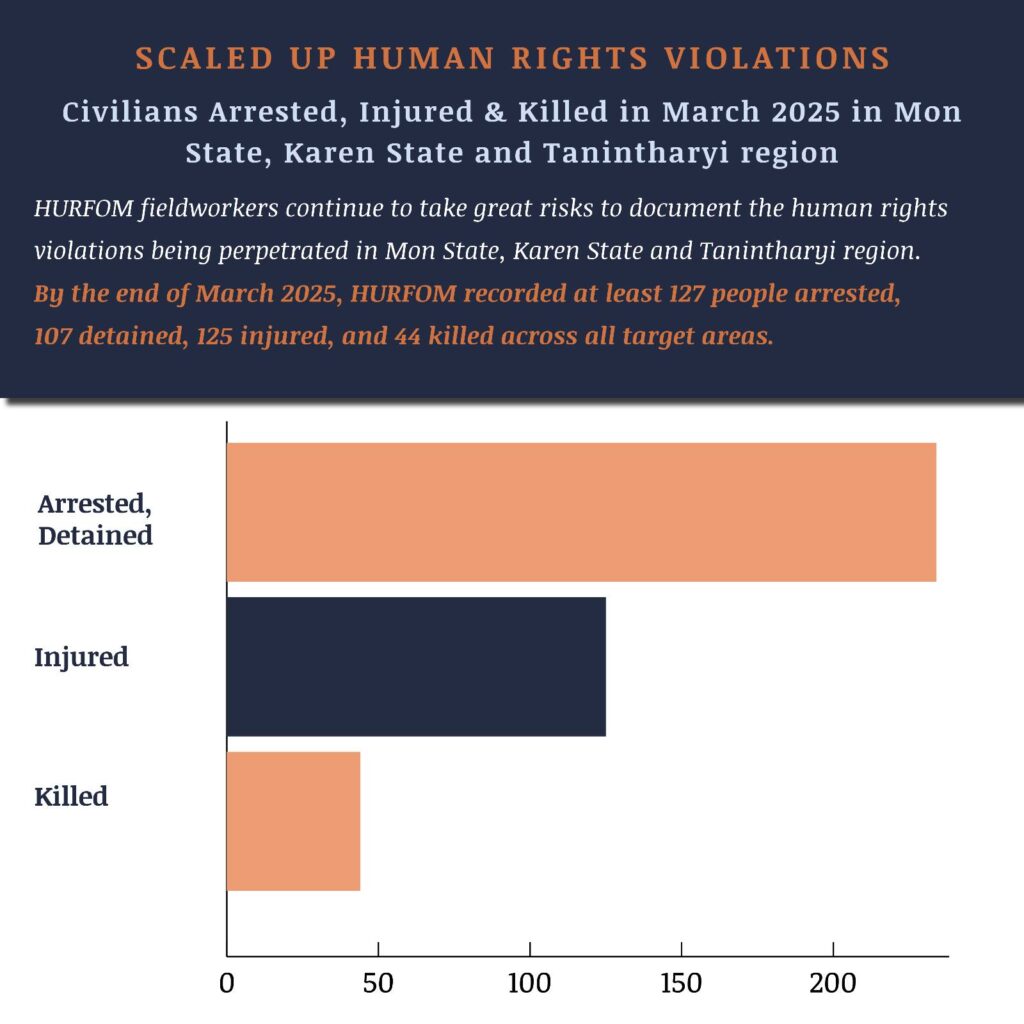
Forced Conscription
In addition, the forced conscription bid continues to have detrimental impacts on communities, especially amid announcements that the regime has begun the enlistment of women and girls who face serious threats to their safety while in the presence of the regime. The lack of support for forced conscription also comes amid increased checkpoints by the regime, which is actively engaging in an illegal campaign of extortion of properties and finances. At the Than Bridge checkpoint on the Yangon-Mawlamyine highway in Tha Pyay Ni village, Bilin Township, Mon State, at least seven young travellers were arrested by the military junta’s troops on March 2nd, including two young men. After soldiers had checked their phones, they were immediately taken into custody, a witness reported.
“I don’t know who they were, but after the soldiers checked their phones, they arrested them on the spot,” said a resident.
Earlier, on February 24 at 5:00 PM, junta troops stopped a passenger vehicle traveling from Thaton to Bilin and arrested five young passengers at the same checkpoint. They were reportedly returning from Myawaddy due to restrictions on cross-border trade and were en route to Yangon. Throughout early March, junta forces in Bilin Township intensified their arrests of young people, sending some to military training and extorting money from others through intimidation.
Since the enforcement of the military conscription law in Mon State, the junta has reportedly conscripted over 2,000 people up to batch 10, according to sources close to the junta and local authorities. In January 2025 alone, reports indicate a sharp rise in forced conscription and arbitrary arrests across Mon State, with at least 60 individuals detained for various reasons and over 15 forcibly taken for military service. The ongoing arrests and forced recruitment have spread fear among young people, with many now avoiding travel between townships to escape potential detention at junta checkpoints.
The military junta has been continuously arresting young people in Bilin Township, Mon State, with at least 15 youths detained between the first and second weeks of March. On the evening of March 9th, junta forces raided homes in Zot Thoke village, Bilin Township, and arrested more than 10 youths, including women.
“We still don’t know the reason behind their arrests, and we haven’t been able to contact them yet. Our biggest concern is that they might be sent for forced conscription,” said a resident.
As reported by local sources, most of those targeted are between 18 and 35.
“Every night, the junta inspects young people walking around. They arrest them under various pretexts. Many are taken in the middle of the night without anyone knowing. Some disappear without information, while others are only released after paying large amounts of money,” said a local man.
The junta continues to raid homes at night, detain young men travelling on motorcycles, and inspect the mobile phones of travellers as part of its intensified crackdown. In February alone, more than 50 people were arrested in Mon State, including during mass arrests, according to reports. The ongoing arrests, combined with forced conscription and ransom demands, have created widespread fear among local families, with many young people forced into hiding to avoid being taken by the junta.
Hundreds of recently trained junta soldiers, many forcibly conscripted young men from the local area, have been deployed to reinforce military bases in Dawei. These newly trained troops, assigned to junta battalions in the region, have now begun military operations targeting eastern Dawei villages.
On March 18, a large-scale military column of approximately 200 junta troops advanced from Sipinkauk village toward Pakari village, triggering mass displacement. According to local sources, since the offensive began, hundreds of residents have fled their homes, fearing imminent attacks from artillery shelling and drone strikes. Villagers, particularly women and children, have been moved to safer locations as communities urgently prepare for the escalating conflict.
“The situation is extremely concerning. People are apprehensive about sudden airstrikes and drone attacks. We are doing everything we can to ensure the safety of women and children,” said a displaced resident.
As the junta forces push deeper into rural Dawei, residents from Sipinkauk, Laitaung, Zaloon, and Katat villages have abandoned their homes, seeking refuge in safer areas. Many fear being caught in the crossfire between junta troops and local resistance forces stationed in eastern Dawei.
A Pakari village resident shared, “We are very worried that fighting will intensify as the junta forces continue their advance. If a battle breaks out, civilians will be trapped in the crossfire.”
The advancing junta battalion, Light Infantry Battalion No. 402, primarily comprises soldiers who recently completed their forced military training under the junta’s compulsory conscription law. Many of these young conscripts were forcibly recruited, subjected to minimal training, and deployed into front-line combat zones.
This latest operation follows a series of brutal military offensives in Dawei Township earlier this month. In early March, junta troops raided and occupied Tha Pyar, Pakari, Wakone, Baematat, Wapyin, and Thingan Tone villages, displacing thousands of civilians. Local sources report that junta forces have been targeting communities with arbitrary arrests, forced conscription, and indiscriminate artillery attacks.
On March 14th, three villagers from Maungmakan were arrested by junta forces at the Kamyawkin Bridge checkpoint in Launglon Township, Dawei District, Tanintharyi Region. The families confirmed that the three men were detained arbitrarily and forcibly sent to an army camp as part of the junta’s ongoing forced conscription efforts.
The three villagers, 32-year-old Ko Pha Hsu Thar from Kabweehnapin Village in Maungmakan Village Tract, 20-year-old Ko Thar Gyi, and an unidentified man from Maungmakan New Ward—were returning home after docking their fishing boat in Dawei town when they were detained. Family members said junta troops interrogated and detained the three men at the Kamyawkin Bridge checkpoint:
“They were going home after docking their fishing boat in Dawei. They were detained at the checkpoint. We heard that they were initially taken to the main administrative office in Dawei. Families tried to meet them there, but they weren’t allowed. They only saw them being loaded onto a military truck,” explained a family member close to one of the detainees.
On March 15, at 9:00 PM, the arrested villagers managed to contact their families by phone, informing them they were being transported by boat.
“One boat full of detainees had already left. They were waiting for another boat. After that phone call, we completely lost contact,” said the mother of one detainee.
Family members expressed their concern, believing the detainees might have been sent to recruitment camps in Myeik or Kawthaung townships. Residents also confirmed that individuals arrested in similar cases are typically transported via sea routes to military recruitment camps in Myeik. In November 2024, over 50 men, including fishermen, were similarly arrested at the Pulaw Bridge checkpoint and forcibly recruited into military training camps.
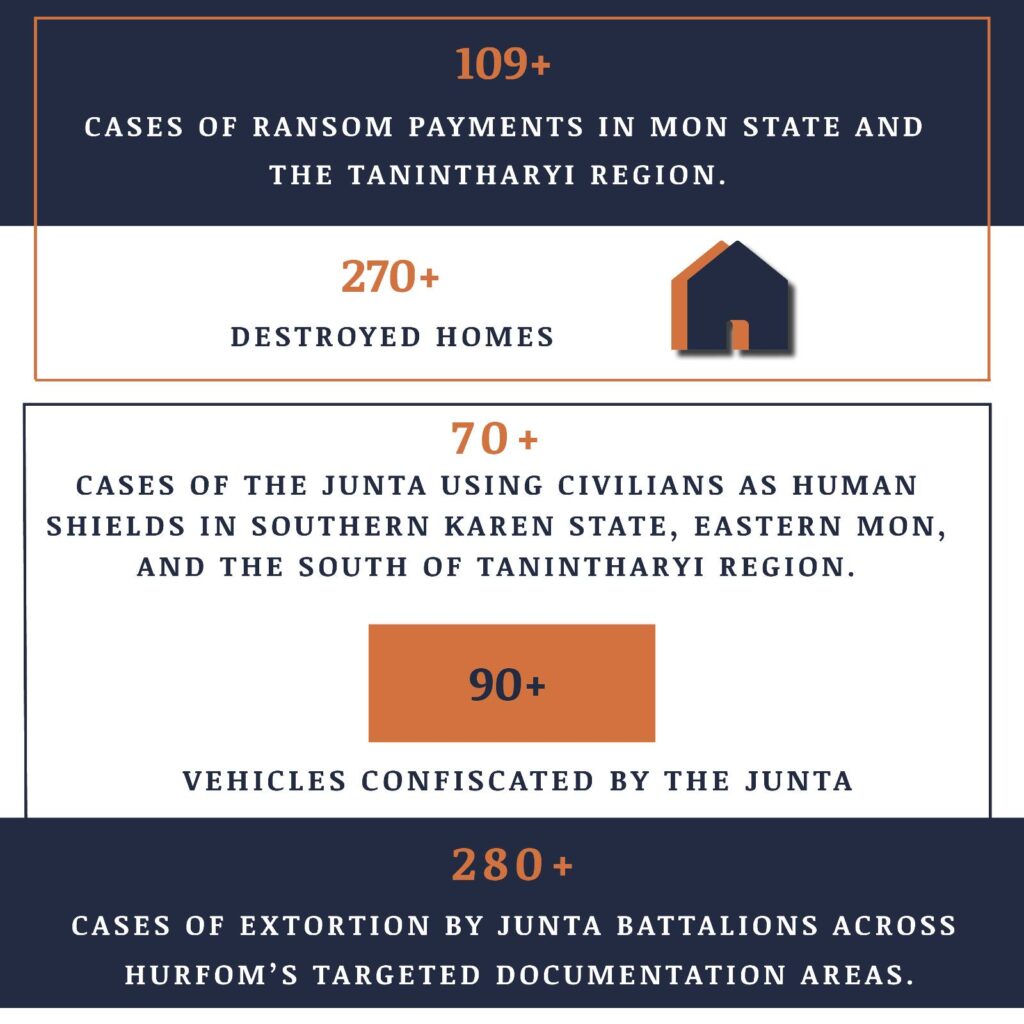
Landmines
Landmines continue to pose devastating risks for civilians. A 52-year-old woman suffered severe injuries after stepping on a landmine planted by junta troops at the Yuzana oil palm plantation in Bokpyin Township, Myeik District, Tanintharyi Region.
The incident occurred around noon on March 12 while she was working at the plantation owned by Yuzana Company. A resident from Chaung Mon village reported that the explosion caused her leg bone to fracture and shatter.
The woman received emergency medical treatment before being transported to Bokpyin Hospital for further care. Amid ongoing clashes between resistance forces and junta troops in the region, local resistance groups have repeatedly warned villagers to stay away from unexploded military weapons and landmines. The junta forces in the area had reportedly planted at least 14 landmines around the Yuzana oil palm plantation when they established their base but failed to remove them afterward, leading to civilian casualties, including plantation workers.
In a related case, three family members, including an 11-year-old child, were injured in Lae Thit village, Tanintharyi Township, Myeik District, after a detonator exploded inside their home, according to local sources and resistance forces. The incident occurred at 6 AM on March 10 when the family attempted to connect the detonator—locally known as “Kit Thee”—to a battery, triggering an unexpected explosion.
“At the time of the explosion, five family members were inside the house. A 43-year-old woman, a 30-year-old woman, and an 11-year-old child sustained minor injuries, while the other two were unharmed,” said a resident.
Due to the presence of unexploded ordnance and remnants of war in the region, awareness campaigns on landmines and explosive devices are regularly conducted in Lae Thit village and surrounding areas.
A detonator is an explosive component often used as a fuse for larger explosives. Some types require a battery connection, while others are ignited by flame. Accidental detonations continue to pose a serious risk to civilians in conflict-affected areas.
Drone Attacks
The military junta in Mon State has intensified its drone attacks on villages in Kyaikhto Township despite no active clashes in the area. These targeted strikes have led to civilian injuries, the destruction of homes and public infrastructure, and significant damage to livelihoods, including farms and businesses.
Military analysts have noted that the junta’s use of high-performance drones for targeted attacks has increased following Min Aung Hlaing’s recent trip to Russia. The main perpetrators of these assaults are troops stationed at Light Infantry Battalion No. 207 and Artillery Regiment Command No. 310, based in Kyaikhto Township. These units are responsible for issuing and executing the majority of attack orders. As of March 15, at least seven villages in Kyaikhto Township have been repeatedly attacked, with over two dozen strikes recorded.
“More than 20 homes have been destroyed, and at least 14 people have been injured, four of whom are in serious condition. The attacks have been particularly severe in Pyinkadone Kone, Khayae, Sitkwin, Mokekha Moh, and Thone Kwa villages,” said a local resident.
The junta justifies these attacks by claiming resistance forces are hiding in these areas, but in reality, it is civilians who bear the brunt of the violence. Many families have been forced to flee their homes, while others remain trapped in fear. A 45-year-old man from Kyaikhto Township shared his firsthand experience:
“Our home was hit by a drone attack on March 1 in the afternoon. I grabbed my three children and my wife, and we ran as soon as we saw the shells dropping. We left everything behind and haven’t returned since. My children are still traumatized by what happened,” he said.
Another villager from Sitkwin confirmed the severity of the situation:
“In the first week of March alone, the junta carried out at least eight separate attacks on our villages,” he said.
In a separate incident, on March 16, a Mokekha Moh villager described how the junta’s drone division stationed at Kwali Lake Hill launched six bombs in Pyinkadone Kone Cemetery and a 100-acre stone mining area.
“I was nearby when it happened. The explosions injured several villagers. Thankfully, resistance medics and doctors could provide treatment,” he explained.
Beyond drone strikes, the junta has also intensified heavy artillery shelling in the region. Since March 1, Artillery Regiment No. 310 has fired at least 10 heavy artillery shells, while Light Infantry Battalion No. 207 launched eight additional strikes, causing further devastation in Kyaikhto Township, Mon State.
Between March 4 and 6, junta forces escalated their offensive with airstrikes and heavy shelling, causing widespread panic and forcing many civilians to flee their homes. Farms and agricultural land have been severely damaged, adding to the economic hardship of already struggling communities.
On March 12 and 13, drone attacks struck the Kanyin Ai, Wardadkwin, and Mokekha Moh villages, injuring two resistance fighters and four civilians. The junta’s aerial assaults have not been limited to Mon State. In February 2025, similar air raids targeted two villages in Bilin Township, Mon State, and Anankwin village in Kyainseikgyi Township, Karen State. These attacks destroyed at least 26 homes and injured more than 13 civilians.
The indiscriminate and systematic attacks on villages in Mon and Karen States reflect a clear strategy of targeting civilians under the pretext of military operations. As a result, families are being torn apart, livelihoods are being destroyed, and entire communities are being displaced.
Mon State
A father and daughter from Mokanin village, Ye Township, Mon State, were detained by junta forces from Infantry Battalion 106 and lost contact with their family for more than two months. The daughter was released, but her father remains behind bars with no sign of release.
The arrests took place on December 13, 2024, at 5:00 PM, when 54-year-old Ko Soe and his wife, Mi Wu, were taken by junta soldiers. The following day, on December 14, their 23-year-old daughter, Ma Thin Thin Soe, was also arrested from their home.
Two weeks after the arrest, Mi Wu was released. Still, according to a family member, Ma Thin Thin Soe remained in detention for nearly two months before finally being freed in February 2025. Sources close to the junta say that Ko Soe and his family were accused of supporting the People’s Defense Forces (PDF). Junta forces raided their home and conducted a thorough search before taking them into custody.
A close family member reported that Ko Soe was initially held at a military base in Mawlamyine before being transferred to Kyaikmayaw Prison. The junta is preparing to charge both father and daughter under terrorism-related laws, specifically under Article 50(j) of the Anti-Terrorism Act.
Residents of Mokanin village insist that Ko Soe and his family have no political affiliations. They are ordinary civilians working as traders in betel nuts, farmland, and rubber plantations. The junta’s arrests of civilians have escalated in recent months. Over 20 people were arrested in Mon State in February alone, while more than 50 individuals were detained in January 2025.
In December 2024, junta forces in Ye Township arrested 17 locals, of whom 11 were later released. In addition, the junta has detained over 40 rescue workers and humanitarian volunteers from Ye, Kyaikhto, Mawlamyine, Mudon, and Thanbyuzayat townships, accusing them of links to resistance forces. Some of those detained have already been sentenced to long-term imprisonment.
In a separate case, two civilians were injured when the military junta carried out a drone attack between Alu Lay and Pai Dawei villages in Bilin Township, Mon State, when the junta forces launched an airstrike on March 10th at 2 PM. The attack targeted a Karen National Union (KNU) checkpoint along the road connecting the two villages. During the attack, one of the drone bombs detonated near the village road junction, causing serious injuries to two civilians.
The victims have been identified as 60-year-old U Than Hlaing and 51-year-old U Zaw Htun, both from Alu Lay village. They were returning home from their farmland when the explosion occurred.
“U Than Hlaing suffered severe injuries and is in critical condition. He has been transferred to Bilin Township Public Hospital for urgent medical treatment with the help of local villagers,” said a resident from the area.
Since January 17, 2025, the military junta has intensified its attacks in Bilin Township, using airstrikes, drones, and heavy artillery shelling on a near-daily basis. The junta has been targeting key supply routes, cutting off access to food and essential goods while continuing its relentless bombardment of civilian areas.
Meanwhile, KNLA Brigade 1 and Brigade 5, along with allied forces, have been surrounding and attacking the junta’s Security Command Headquarters No. 8 based in Mae Plai village for nearly four weeks. In a similar attack on February 11, junta forces launched an artillery strike on Pyin Thar village, also in Bilin Township, injuring a mother and her child.
The continued assaults have caused widespread fear among civilians, forcing many to flee their homes in search of safety. As the conflict escalates, communities in the Bilin Township remain under constant threat, with no signs of relief from the junta’s indiscriminate attacks.
On 21 March, at 9:33 AM, an 81mm mortar shell was fired from the home of Aung Gyi, a leader of the pro-junta militia in Latpan Village, Waw Township, Bago Region. The attack occurred without any ongoing clashes in the area, as junta-backed forces recklessly launched indiscriminate artillery fire.
Tragically, the shell landed inside the northern monastery of Khaywe Village in Kyaikto Township, Mon State, exploding near the monastery’s dining hall and prayer room. As a result, one monk, U Uzin, was killed, while two other monks sustained serious injuries. The shelling also caused significant damage to the monastery and forced around 30 nearby households to flee in fear for their safety.
This brutal and senseless attack on a sacred religious site, where monks and civilians had gathered for their daily prayers, is an appalling violation of human rights and an undeniable war crime. The junta and its allied militias continue to escalate their targeted violence against innocent civilians, including religious communities, in their desperate attempt to maintain control.
Another concern has arisen because junta forces and their affiliated departments have been using the Person Scrutinization and Monitoring System (PSMS) to inspect and detain individuals they consider suspicious at the entry and exit points of Mawlamyine. On March 15, a young man was arrested at a junta checkpoint near Attaran Bridge in the industrial zone after being screened through the PSMS system. Junta-controlled media and sources close to the regime confirmed the arrest.
Passengers travelling from Hpa-An to Mawlamyine on a Myat Yadanar Min white light truck were subjected to PSMS screening via a tablet. During this inspection, 33-year-old Swan Pyae Sone, a Shwe Myain Thiri ward resident in Mawlamyine, was arrested.
“They used the PSMS system on a tablet to identify him. The system displays detailed personal information, including photographs,” a resident from Mawlamyine explained.
Although Swan Pyae Sone had no known criminal record in Mawlamyine, authorities claimed that he had an outstanding case under Article 50(j) of the Anti-Terrorism Act at the Meiktila Township police station in the Mandalay region. He was then taken into custody at the industrial zone police station.
The junta has been expanding its surveillance capabilities through the National Database System, which was first introduced on May 22, 2022, and later reorganized on August 19, 2023. As part of this system, the regime has been collecting personal data and biometric information while conducting extensive screenings. The system assigns Unique ID (UID) numbers and operates through a five-step verification process to track and monitor individuals.
This latest arrest raises concerns over the junta’s increasing use of digital surveillance to target civilians, particularly those traveling through checkpoints in conflict-affected areas.
Karen State
A devastating airstrike by the Junta targeted the Kyauk Kwin Monastery in the Kamamaung sub-township, Papun District, within the Karen National Union (KNU) Brigade 5-controlled territory in Karen State, resulting in the death of a senior monk.
The attack occurred around 4 PM on March 5, when fighter jets dropped bombs on the monastery, destroying the building. Tragically, 62-year-old Abbot Annanta Witunda, who had been ordained for 41 years, was killed instantly. A local woman who witnessed the aftermath described the severe impact of the explosion on the monk’s body.
In addition to the abbot’s death, the airstrike injured another monk and a young novice inside the monastery. They were rushed to Hpa-an Hospital via Kamamaung Town for urgent medical treatment. Kyauk Kwin village, located approximately nine miles from Kamamaung Town, has been under relentless assault. The junta has been carrying out daily airstrikes in Brigade 5’s territory, with Kyauk Kwin being among the latest targets.
Since the third week of February, villages around Kamamaung have suffered repeated bombings and artillery shelling, destroying religious sites and civilian homes. The escalation of attacks has forced residents from at least five villages to flee their homes, with many seeking refuge in the Myaing Gyi Ngu area near Kamamaung Town.
The increasing airstrikes in the region have not only claimed lives but also shattered communities, leaving people displaced and fearful of further violence. In another case, two innocent lives were lost in Karen State when a junta jet fighter launched an airstrike on a peaceful village where no fighting had taken place. The attack has left local communities shaken, questioning the junta’s increasing pattern of targeting civilian areas without provocation.
According to a field report released on March 21 by a human rights monitoring network, the military junta dropped bombs on Tabalukhokhee village in Kawkareik Township around 11:00 AM on March 19. The area lies within the Karen National Union’s (KNU) controlled territory, and no armed clashes were seen during the strike.
A Yak-130 jet fighter, flown from Naypyidaw, delivered the deadly payload that killed two local men, aged 36 and 30. Both suffered fatal injuries from the blast. In addition to the heartbreaking loss of life, a family home and a small storage building were also destroyed in the attack.
“There was no fighting here. We were just living our lives. Now two people are gone, and families are grieving,” said a resident, still in shock.
Locals and resistance fighters believe the attack is part of a growing pattern of fear tactics the junta uses. Following concerns that joint resistance forces may soon challenge junta control over Kawkareik town, the military has ramped up shelling and airstrikes on surrounding villages—regardless of whether clashes are occurring.
“In the past, they targeted areas closer to the town. But now they’re bombing villages further out, with no warning or justification,” said a member of the resistance in the area.
“The junta is conducting the so-called ‘Aung Zayya’ operation, splitting into four military columns and moving unpredictably. No one knows where they’ll strike next.”
This is not an isolated incident. Earlier in the month, on March 4 and 5, airstrikes were reported in Ason village and near a school in Dawplar (Baw Dine) village. Again, there were no armed clashes in those areas, yet civilians suffered casualties, and critical infrastructure was damaged.
Two children, aged six and eleven, were injured by artillery shelling in Kawkareik Township, Karen State. The incident occurred at approximately 4:30 PM on March 23, when an artillery shell landed directly on the house of U Aung Myo Min, located in Ward No. 2 of Kawkareik. The explosion seriously injured two children inside: Maung Sai Wai Yan Myo, an 11-year-old Grade 3 student, and Ma Lin Lae Nay Chi, a 6-year-old kindergarten student.
“The two children sustained serious injuries, but thankfully, their conditions aren’t life-threatening,” explained a local resident. “The shell was fired from an area outside the town.”
The children were initially taken to Kawkareik Hospital and later transferred to Taung Kalay Hospital in Hpa-An for more specialized care. Earlier this month, on March 9, another serious incident occurred in Kawkareik Township. Between 5:30 AM and 8:20 AM, the Mon State Liberation Army’s (MLA) Spring UAV Force-G3 Fixed-wing drones dropped three bombs targeting a bridge-opening ceremony organized by the military junta. According to the MLA’s statement on March 10, three civilians were killed and at least five others injured during that drone attack on the Myawaddy–Hpa–An road.
Tanintharyi Region
There continues to be a worsening trajectory of violence in the Tanintharyi Region with aerial assaults, indiscriminate firing and arbitrary arrests that have proved to be fatal in many cases. HURFOM remains alarmed at the deteriorating conditions civilians must endure as they struggle to survive.
A 44-year-old man from Myeik, U Rama Zan Khan, succumbed to his injuries four days after being shot by junta troops in Yebyu village, Tanintharyi Township, Myeik District.
On the morning of March 11, U Rama Zan Khan and his son were traveling by motorcycle to buy goats when they were suddenly fired upon by junta troops stationed in an ambush near the No. 3 Military Strategy Camp of the Coastal Region Military Headquarters. The attack took place on the Tanintharyi-Bote Pyin Union Road in Yebyu village.
“They were on their way to buy goats when they were shot at near Yebyu junction. The son was unharmed, but the father, who was sitting at the back, was struck by two bullets,” a resident said.
U Rama Zan Khan sustained gunshot wounds to his arm and abdomen. He was given immediate medical care before being transferred to the public hospital in Tanintharyi on March 12. Later that night, he was transported to Myeik Public Hospital for further treatment. Despite medical efforts, he passed away from his injuries on March 14 in the evening. His funeral was held on March 15, in accordance with Islamic traditions, surrounded by grieving family members and friends.
Residents of Yebyu Township in Dawei District, Tanintharyi Region, have been forced to flee their homes following a renewed military offensive by junta troops into the Dawei Special Economic Zone, local sources report.
The escalation began on March 13, at 7:00 AM, when the People’s Defense Forces (PDFs) launched coordinated attacks on two junta outposts: one at Maungmagan Police Station in Long Lone Township and another at Lek Khat Taung, situated between Long Lone and San Hlam villages.
In response, junta troops from the Maungmagan police station advanced into the Dawei Special Economic Zone, reaching Mudu village. There, they detained and interrogated approximately eight villagers before releasing them.
“We had no choice but to flee. We left early to avoid getting caught in the middle of the offensive,” said a resident who fled the area with their family.
Tensions escalated again on March 20, when more residents were forced to flee. A junta column of over 100 soldiers launched a further offensive from the Dawei deep-sea port toward Para Dat village.
The offensive operation is reportedly being carried out by a joint force of Infantry Battalion 104, stationed east of Maungmagan, along with troops already inside the Special Economic Zone. So far, this latest operation has reported no direct clashes between the junta and resistance forces.
According to local analysts, the military’s renewed interest in securing control of the area follows the recent signing of a Memorandum of Understanding (MoU) with Russia to jointly develop the Dawei Special Economic Zone. Just one day after the Chief Minister of the junta in the Tanintharyi Region publicly announced plans to advance the SEZ project, reinforcements were deployed to the area, prompting a wave of displacement among residents. The continuing militarization of the SEZ has heightened fear and instability among local communities already facing the brunt of armed conflict.
Meanwhile, conscription by the junta remains an ongoing concern. Local witnesses report that young men passing through military checkpoints at the entrances and exits of Dawei are being detained and forcibly sent to military training camps. On March 4, a 28-year-old displaced man from Ya Nge village in Tha Yet Chaung Township was detained at the Byaw Taw Wa military checkpoint near Dawei’s entrance. He was immediately taken to the military recruitment office in Dawei and forced into conscription.
“He was brought to the recruitment office, but when we contacted local administrative officials, they told us there was nothing they could do to release him,” a family member of the detainee said.
The same day, four other young men from Maungmagan were arrested at the Ka Myaw Khin Bridge checkpoint while returning home from a fishing trip. Military personnel at the checkpoint denied detaining anyone when family members tried to inquire. These young men were first sent to a training school in Shwe Du village, Myeik Township, specializing in combat and recruitment training. On March 15, they were transferred to the No.12 Advanced Training School in Palauk.
On March 17, the junta began its 11th nationwide batch of military training for forcibly conscripted youth. Beyond physical checkpoint arrests, the junta has also started using digital ID checks to locate and detain young people without warning, heightening local fears.
Consequently, many eligible young men have fled the country or gone into hiding abroad to avoid forced conscription since the conscription law came into effect. Sources also revealed that drug-related prisoners are being offered reduced sentences or complete pardons if they agree to serve two years in the military, further highlighting the junta’s aggressive conscription practices.
Ongoing clashes between junta troops and local resistance forces near Nyin Htwe and Kyauk Kanyar villages in Yebyu Township have resulted in the death of one local man and the displacement of hundreds of villagers.
On March 24, at 10:00 AM, a 40-year-old man named Ko Nge Thar from Nyin Htwe village was killed when an artillery shell fired by the junta’s Artillery Regiment Command No. 304, based in Kyauk Kanyar, exploded near his home. Residents reported that four shells were fired in total, with one landing just outside Ko Nge Thar’s house as he was returning from his plantation by motorcycle. Shrapnel from the explosion struck him in the chest, causing his immediate death.
“He was just returning home on his motorcycle when the shell landed in front of the house. He was hit in the chest and died on the spot,” said a Nyin Htwe villager who witnessed the incident.
Clashes reportedly began at 9:00 AM when resistance forces ambushed junta troops in the area. During the exchange, a military aircraft was seen circling above Nyin Htwe and Kyauk Kanyar villages, prompting fears of an impending airstrike.
These recent military movements are linked to the junta’s renewed push to secure the area for the resumption of the Dawei Special Economic Zone (SEZ) project in coordination with the Russian government. Since March 13, junta forces have been reinforcing their presence in the area, with a unit of over 100 troops launching operations inside the SEZ zone starting on March 20.
On March 24, at 1:00 PM, another confrontation occurred near Lae Shaung village, near the Cha Taw Yar Pagoda in the Nabule area. As a result, residents from nearby villages—including Paradat, Lae Shaung, and Htain Gyi—were forced to flee their homes and urgently needed shelter and protection.
A local from Nabule explained:
“People are fleeing quickly. The fighting is getting closer, and we fear both ground clashes and airstrikes. Many families have left everything behind.”
It is worth noting that earlier, on March 11, the junta-appointed Chief Minister of Tanintharyi Region stated during a government meeting that preparations were underway to resume work on the SEZ project, sparking concern among local communities who fear increased militarization and violence as a result.
In a brutal attack with no active fighting in the area, two civilians were killed after the military junta dropped two 500-pound bombs on a palm oil plantation in Chaung Lamu village, Myeik Township, in the southern Tanintharyi Region. According to residents, the airstrike took place without any prior clashes or warning.
At 4:15 PM on March 24, a junta aircraft dropped two bombs on the plantation operated by the Kyaw Maw-19 palm oil company in Chaung Lamu. The bombs exploded near the workers’ housing area inside the company compound, killing two male workers, aged 27 and 33.
“There are over 40 workers at the plantation. Two died, and more than six others were injured. Their housing was also completely destroyed,” said a local man.
Witnesses said the jet came twice. The first bomb did not cause any injuries, but the second strike resulted in casualties. Local sources report that the junta’s offensives in this area have continued for over three months. Airstrikes and indiscriminate artillery shelling near civilian villages around Thein Khun and neighboring areas have already resulted in several civilian deaths and injuries.
Just days earlier, on March 21, four displaced civilians who had returned to Chaung Lamu village to retrieve food supplies from their homes were killed when junta forces fired heavy artillery into the area.
These incidents reflect a growing pattern of violence where civilians, especially those in conflict-affected and displacement zones, are increasingly targeted—often with no warning and in areas far from the front lines.
In just one week, four civilians—including a pregnant woman—were tragically killed by artillery shelling from junta forces in Tanintharyi Township, Myeik District. Troops stationed in Thein Khun village reportedly fired heavy artillery toward nearby areas, with shells landing in Chaung Lamu village, located across from Thein Khun. The strikes resulted in multiple civilian casualties.
On March 21, at 3:00 PM, as residents of Chaung Lamu were transporting rice after fleeing earlier clashes, artillery shells struck the group. Among those killed were Daw Mi Mea, a 35-year-old pregnant woman, and her brother U Thaung Pu, age 38.
“They were just trying to transport rice for survival after escaping the fighting. They died together,” said a resident from Thein Khun village.
Two other men from Chaung Lamu, aged 25 and 26, were severely injured during the same attack. One of them succumbed to his injuries later that evening. Earlier that week, on March 16, a 40-year-old man from Chaung Lamu village was also killed instantly when another round of junta shelling hit the area.
Since March 17, intensified artillery shelling and airstrikes have forced nearly all residents of Chaung Lamu to flee, seeking safety and emergency shelter elsewhere. Heavy fighting between junta forces and local resistance groups has continued in Thein Khun village tract since late December. Over the past week alone, Thein Khun, Chaung Nya Pauk, and Chaung Lamu villages have been targeted by near-daily airstrikes, with junta aircraft carrying out at least 14 bombing raids. Download the full report



